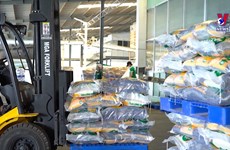Rosier economic picture expected for final quarter
The fourth wave of COVID-19 to strike Vietnam seriously affected the country’s economy and especially the southern region, including Ho Chi Minh City and Binh Duong, among others.
This was concerning, as 19 cities and provinces in the south of the country contribute nearly half of total GDP.
Pham Dinh Thuy, head of the Industrial Statistics Department under the General Statistics Office, said more than 50 percent of cities and provinces nationwide saw a downwards trend in industrial production during the third quarter. The fourth wave of COVID-19 has clearly disrupted supply chains and export activities in the economy as a whole and especially in the south.
Many localities introduced measures to prevent the spread of COVID-19, including the “three-on-the-spot” strategy (where employees live, work and eat on-site) to curb the pandemic.
While these measures helped control the spread of COVID-19, they also created difficulties in production.
“The 'three-on-the-spot' strategy causes backlogs, resulting in higher selling prices, and enterprises will be short of cash flow,” said Vu Van Tien, Chairman of the Board of Directors of Geleximco Group.
According to experts, one of the crucial elements in Vietnam’s economic picture has been its macro-economic stability.
According to Nguyen Thi Hong, Governor of the State Bank of Vietnam, the macro-economic situation in the first nine months of 2021 remained stable, with inflation controlled at a low rate and a trade surplus being posted. Vietnam’s economic growth remains positive and is the brightest among Asian countries.
Another highlight of the country’s economic growth compared to the time during previous waves of COVID-19 is the greater recoverability thanks to changes in strategy to live safely with the pandemic./.













